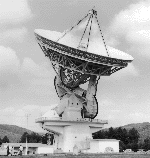Try It At Home! Make a Radio Image!
Radio waves are emitted by planets in our solar system, chemicals in comets and in the Milky Way Galaxy, supernovae, and by other galaxies and distant quasars. These radio waves travel through space just like light, and radio telescopes can intercept them. Astronomers often convert these signals into pictures. Here are three "radio pictures" showing:
They look like photographs don't they? But radio waves are invisible! So, how do scientists make "radio pictures" of the objects in the Universe?
Print out Data Sheet 1, or Data Sheet 2 and you can make a radio picture! Notice all the little squares? Let's call each one of these squares a pixel. Each pixel stores information about the radio waves coming from a point in space. The pixel beside it stores information from the very next spot in space and so on. A radio telescope scans across an object and receives radio waves from each little spot in space around that object. Some spots may have stronger radio waves coming from them than others. This imformation is stored in pixels. The computer turns this information into numbers. For example, if radio waves are weak at a particular position, a small number would be recorded in the pixel. If no radio waves were coming from that spot, the computer would put a zero in that pixel. Astronomers may spend hours or even days scanning an object in order to have all the information they need. It may take them weeks to process the data to put accurate numbers in all of the pixels. But once they have all the numbers, they are ready to make a picture. An astronomer will assign a color to each number. You try it! Just pick some nice colors and color by number. What kind of object do you have? Does it look like any of the ones shown above? |



 Radio telescopes look like this. The dish of a radio telescope is made of metal and has a parabolic shape. The 140' telescope, pictured here, is pointing at an object in the universe. Radio waves emitted by that object hit the surface of the dish, and bounce. Because the dish is shaped the way it is, those waves all bounce up to the tip of the telescope, the focal point. The radio waves are focused there. At the focal point, the radio waves enter a sensitive receiver. The receiver amplifies the waves and converts them into a signal that can be stored in a computer. Astronomers use computers to turn this information into pictures. If our eyes were designed to see radio waves instead of light, the picture is what we would see. How do they do that?
Radio telescopes look like this. The dish of a radio telescope is made of metal and has a parabolic shape. The 140' telescope, pictured here, is pointing at an object in the universe. Radio waves emitted by that object hit the surface of the dish, and bounce. Because the dish is shaped the way it is, those waves all bounce up to the tip of the telescope, the focal point. The radio waves are focused there. At the focal point, the radio waves enter a sensitive receiver. The receiver amplifies the waves and converts them into a signal that can be stored in a computer. Astronomers use computers to turn this information into pictures. If our eyes were designed to see radio waves instead of light, the picture is what we would see. How do they do that?